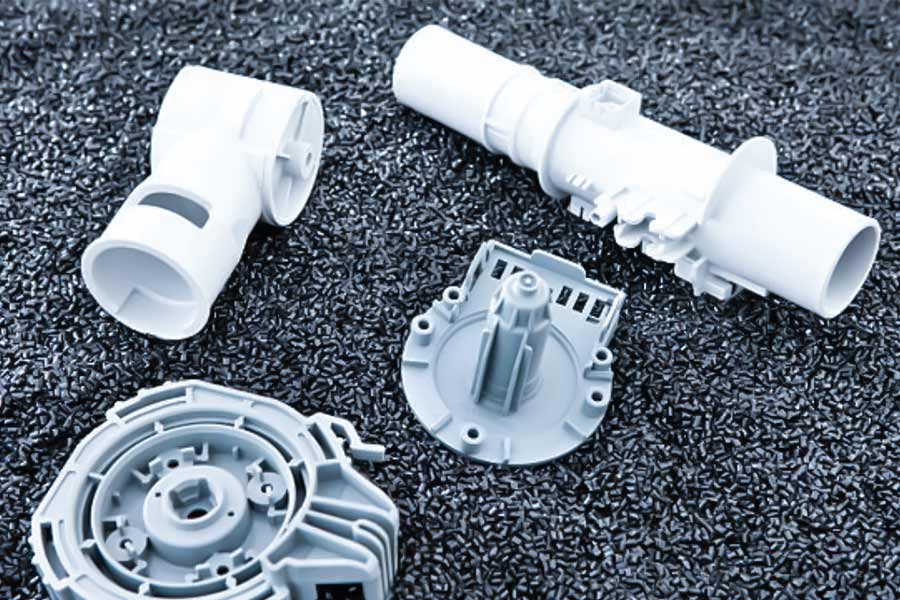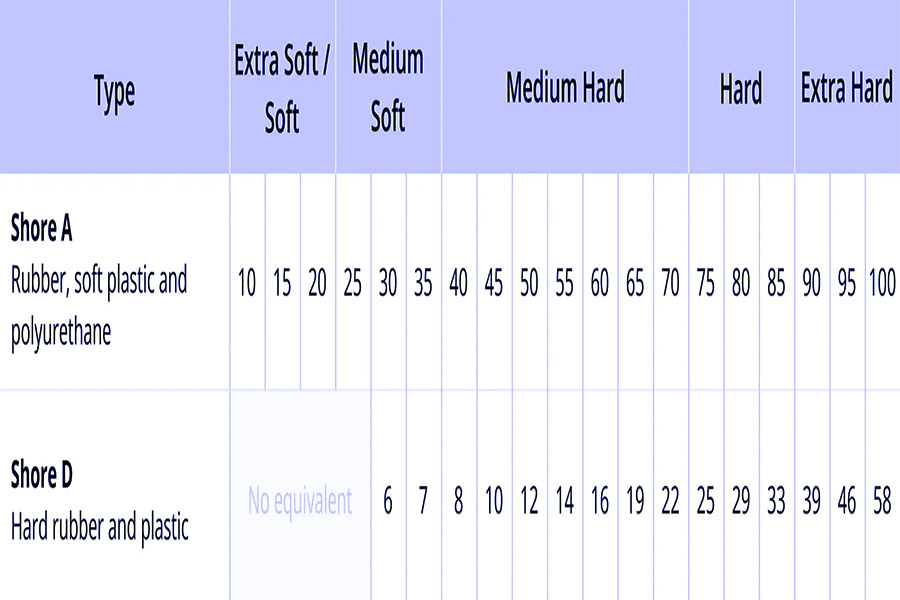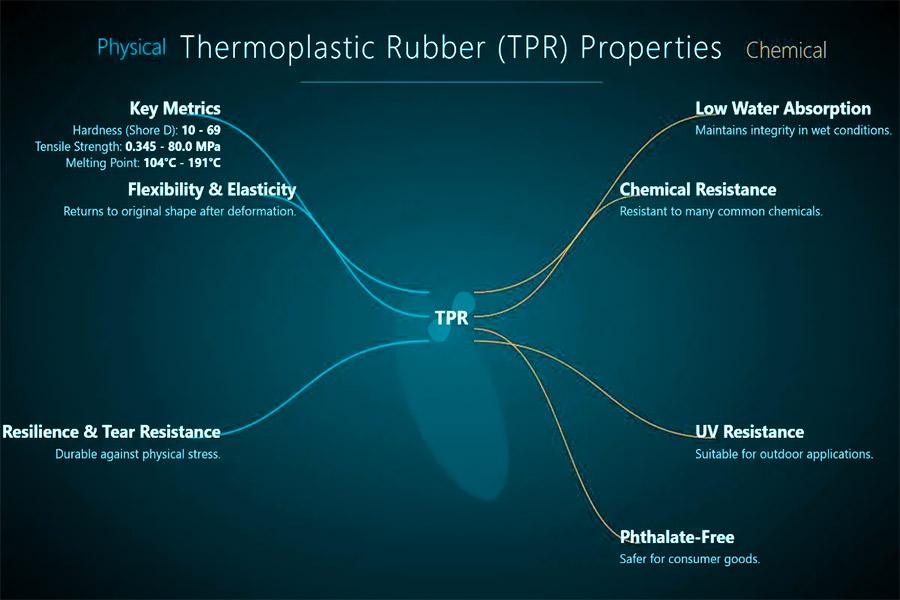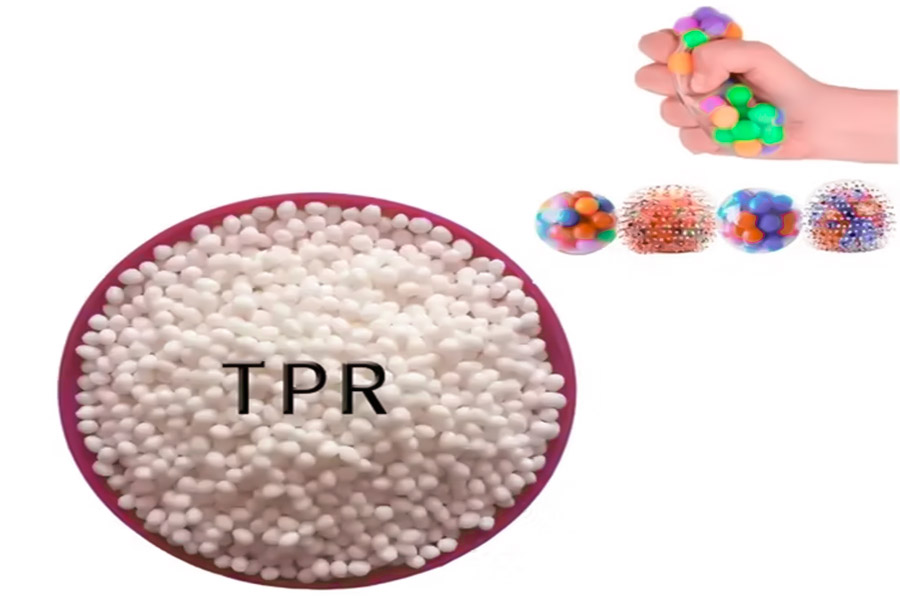You pick up an electric toothbrush, and the handle is soft and non-slip, with an excellent feel. Is it rubber? But it is perfectly integrated with the hard plastic body. What you are experiencing is probablyTPR material, a magical material that looks like both plastic and rubber. This is its core charm: it perfectly combines the elasticity of rubber (softness, rebound, shock absorption) and the easy processing of plastic.
This means that it can be produced quickly and efficiently directly with theinjection molding machinesand extruders we are familiar with, greatly simplifying the process. So you will find that TPR material is everywhere, from toothbrush handles, waterproof layers on shoe soles to sealing strips on cars.
It does not contain latex and is safe and reliable to use.Several key properties make it stand out: it is not easy to crack even after repeated bending, it is not afraid of grease and solvents, it can absorb impact force, and it can be recycled, which is increasingly important. At the same time, it is not easy to become brittle after being exposed to wind and sun for a long time.
It is this excellent balance between elasticity, durability and processing convenience that makes TPR material the preferredmaterial for solving the "balance problem"of engineers and designers, and is widely used in the automotive, medical, consumer goods and construction fields. Next, let's take a closer look at what makes TPR so strong, how it is made, and why it is so indispensable.
Core Answer Summary:
| Core Performance | Key Features | What it means for you in your project |
| Mixed identity | Combining rubber elasticity and plastic processability. | No need for vulcanization, can be directly injection molded, with high production efficiency and low cost. |
| Highly secure | Non toxic, latex free, and benzene free. | Ideal choice for children's toys, medical, and food contact products. |
| Customizable softness | Wide hardness range (Shore 0A-95A). | Realize all kinds of tactility from gel to semi-rigid. |
| Excellent processability | Good fluidity, capable of secondary injection molding (encapsulation). | Easy implementation of complex encapsulation design with high yield rate. |
| Thermal performance | Clear melting point, average temperature resistance. | The processing temperature is easy to control, but not suitable for high temperature environments. |
| Chemical resistance | Water and acid alkali resistance, but poor oil resistance. | Suitable for daily consumer goods, avoid oily environments. |
| Environmental Protection and Aesthetics | 100% recyclable and easy to color. | In line with the trend of sustainable development, the product has a high degree of freedom in exterior design. |
This article will answer your questions:
- This guide will give you an in-depth understanding of the core performance of TPR material and explain why it is both flexible and easy to process.
- We will focus on comparing the key differences between TPR and traditional rubber and silicone to help you make more accurate material choices.
- Finally, through a practical application case of kitchen utensils, we will show how to give full play to the characteristics of TPR to create practical and durable excellent products.
Why Should You Trust This Guide? JS's Material Science And Manufacturing Practice
At JS,TPR materials are our daily life.We not only start production, but also deeply participate in selecting the most suitable TPR material for customers'custom plastic injection moldsmanufacturing projects.
With more contact, you will naturally understand the doorway: for example, if the hardness of TPR is not selected correctly, the product may be stuck in the mold and difficult to demold. Its flow characteristics directly determine whether the thickness of the encapsulation design can be made, and even the difference between differentgrades of TPR and plastics such as ABS and PP.
These experiences are not just talk, but are made by real swords and guns. From baby pacifiers that require absolute safety and comply with the FDA to power tool handles that need to withstand repeated gripping and high resilience, we have worked on hundreds ofTPR projects. How to adjust machine parameters to avoid product burrs? How to design the material channel in the mold to ensure uniform color distribution? These practical problem-solving skills are accumulated through repeated debugging and even handling of small troubles. These practical experiences cannot be found in cold data sheets.
"As the design master Charles Eames often said: details are not just details, they make the design."
Our deep understanding and control of TPR material characteristics and processing details are the core guarantee of the value of this guide. It comes from our real experience in the workshop and next to the mold every day.

In-Depth Analysis Of The 7 Core Properties Of TPR
Property 1: Hybrid identity - is it rubber or plastic?
TPR is neither, it is a uniquethermoplastic elastomer (TPE).It has the soft touch, good rebound and shock absorption of traditional vulcanized rubber, but its biggest advantage lies in the processing method: it is heated, melted and cooled to form like plastic. It does not require the time-consuming heating and curing (vulcanization) process of traditional rubber. This makes production faster and cheaper. Don't worry about whether it is rubber or plastic,it is a unique material that combines the advantages of both.
Performance 2: High safety - Why is it favored by the maternal and child and medical industries?
The high-quality TPR substrates (such as SEBS/SBS) and key additives (such as white oil and resin) we use all meet strict safety standards. Its core advantage is: it does not contain latex (Latex-Free), eliminating the risk of allergies. It does not contain harmful plasticizers such as phthalates (Phthalate-Free), which is the key reason why it is safer and more reassuring than soft PVC. This makes TPR a safe choice for baby products, medical accessories and food contact products.
Performance 3: Customizable Softness and Elasticity
The hardness (Shore A) of TPR can be precisely controlled within a wide range from 0A (close to gel) to 95A (close to hard plastic) through formula design. This means that you can make it as soft as plasticine or as tough as a car seal according to the functional requirements of the product.The feel is completely determined by the design.

Performance 4: Excellent Processability - Born for Overmolding
TPR has good fluidity and can easily fill the small corners of complexplastic injection molds parts. TPR can produce strong adhesion (both chemical and physical bite) with a variety of hard plastics such as ABS, PC, PA, PP. This makes it the preferred material for overmolding.
Imagine: A hard plastic injection mold part as a skeleton, and then a layer of soft TPR wrapped on the outside, forming a strong and non-slip handle in one molding -this is its forte,and it is also a tool for realizing multi-functional and high value-added products in custom Plastic injection molds manufacturing. Its processing efficiency directly affects the cost and product performance.
TPR key processing performance indicators
| Performance index | Typical scope/performance | Describe | Data sources |
| Melt flow rate (MFR) | 5 - 50 g/10 min (230°C/5kg) | The higher the value, the better the fluidity, and the more suitable it is for filling thin-walled and complex structures. | IDES International Plastic Database. |
| Flow length ratio (L/t) | 150:1 - 300:1 | The core indicator for measuring the flow ability of the melt in the mold is the high ratio, which ensures the perfect formation of slender channels/thin walls. | Plastics Technology Magazine. |
| Adhesive bonding force (ABS) | Peel strength: 25-60 N/cm |
The adhesive strength depends on the specific TPR grade, substrate pretreatment, and mold design optimization.
|
SABIC TPE Technical Report (Internal Validation). |
| Permanent compression deformation( 22h@70 °C) | 20% - 45% (ASTM D395) | The key elasticity recovery index, the lower the value, the better the shape recovery after long-term compression. | PolyOne Performance White Paper. |
| Molding cycle efficiency | Shorten by 30-50% compared to rubber of the same hardness | The main advantage comes from the absence of sulfurization, significantly improving production efficiency. | Industry consensus (derived from SPE data). |
Performance 5: Thermal Performance - Its "Melting Point" and Working Temperature
TPR has a clear melting temperature during processing (typical range: 150°C - 230°C), which makes it easy for us to use injection molding machines or extruders to form it. But after being made into a product, its long-term heat resistance is limited, and it can usually only be used stably in anenvironment of -50°C to 80°C.This means that it is not suitable for continuous exposure to high temperature environments (such as boiling water disinfection, application near the engine compartment), and high temperature will cause its performance to decay faster.
Performance 6 & 7: Chemical Stability and Environmental Aesthetics
TPR is usually fine for daily cleaning agents such as water, soapy water, and diluted acids and alkalis. But it has a weakness: it is afraid of oil and organic solvents (such as gasoline, alcohol, and certain cleaning agents), and contact with these substances may cause swelling, softening, or even dissolution. When choosing materials, you must know what your product will come into contact with.

TPR material is very environmentally friendly.Waste, scraps, and even used products (if recycled properly) in the production process can be100% recycledand reused, directly mixed into new materials for processing, greatly reducing waste. At the same time, it is very easy to color and can produce almost any bright and stable color you want, providing product designers with a wide range of creative space.
"The core charm of TPR material lies in its unique combination of "elastomer performance + thermoplastic processing", plus its advantages such as safety, adjustability, easy bonding and environmental protection, making it the preferred material for solving product design problems. Whether you are designing a comfortable grip, a safety seal or a colorful shell, understanding these properties is the key to success. Want to see how TPR material can specifically add points to your product? Contact JS's technical team at any time to talk about your ideas!"
Actual Case Analysis: The Upgrade Path Of Kitchen Supplies From "Bulky Silicone" To "Lightweight TPR"
Choosing the right material is critical. In the past, silicone was too heavy to make kitchenware.Now I use lightweight TPR instead.Direct injection molding is faster and more economical. The lighter the material, the better the feel. It is also easier to meet safety standards and more competitive.
Case: Developing a multifunctional scraper handle for a high-end kitchenware brand
Project background:
A well-known high-end kitchenware brand found us and wanted to develop a new multifunctional scraper. The core requirements are that the handle must be: extremely soft and non-slip, comfortable to hold, bright and eye-catching, and must be firmly combined with the stainless steel handle. Their initial idea was to use silicone overmolding.
Challenges and our insights:
After receiving the customer's design andsilicone overmoldingrequirements, our team carefully evaluated and found some potential problems:
Problem 1:Cost exceeded expectations.Silicone raw materials are twice as expensive as ordinary plastics,and the special overmolding process (such as liquid silicone injection) is more complicated, which leads to plastic injection molds price and unit cost far exceeding the customer's budget.
Problem 2:Low production efficiency. It takes more than 90 seconds for silicone to cure by heating, which makes it difficult to support large-scale rapid supply needs.
Problem 3:There are limitations in design and process. Silicone needs to be coated with primer to bond metal, and the debonding rate of the finished product is 10% (JS internal test data), which customers cannot accept at all.
JS's solution: TPR material
Based on these findings, we did not directly quote according to the silicone solution, but actively communicated with customers and proposed a better alternative:Using TPR material.
Value point 1:Significant cost reduction. We recommended a specific TPR grade that is specially used for coatingmetal insertsand has strong bonding strength. The key is to use an efficient overmolding process. In summary, the total cost per piece is nearly 40% lower than the original silicone solution! This directly helps customers solve the budget problem.
Value point 2:Performance meets the standard accurately.TPR material has a wide range of hardness options.We provided samples of different hardness for customers to experience the feel in person, and finally selected the most comfortable one. At the same time, we ensure that the selected TPR materials fully comply with FDA food contact safety standards, which is very important to customers.
Value point 3:Greater design freedom. TPR material is naturally excellent in coloring performance. We can accurately and fully present the bright brand colors required by customers, and the visual effect is very good.

Comparison of key data of material performance
| Characteristic | Silicone (LSR) | TPR (recommended brand) | Advantages reflected |
| Single piece material cost | $2.1 | $1.3 | Significantly reduced (about 30-50%). |
| Typical mold cost | $85,000 (complex mold) | $48,000 (standard mold) | The price of injection molds has significantly decreased. |
| Colority/Brightness | Good | Excellent | It is easier to achieve high saturation brand colors. |
| Hardness range (Shore A) | Narrower (commonly 20A-50A) | Wide (0A-100A+) | More accurate matching of comfortable grip requirements. |
| Bonding force with stainless steel | Primer required (medium) | Wide (0A-100A+) | Simplified process and higher reliability. |
| Molding cycle time | 60-120 seconds+ | 25-45 seconds | Increase production efficiency by 2-3 times. |
| Typical mold lifespan | 100,000-200,000 times | 500,000-1M+times | Long term production is more cost-effective. |
| FDA food contact certification | Generally consistent | Specific grades comply with | Equal safety standards. |
Data source: Global Polymer Trends Report 2024, International Plastics Association 2024 Annual Report.
Why this solution can win?
The client finally used the TPR solution, and the new product sold more than 200,000 units within three months of launch. The point here is thatwe broke from the inertia of considering silicone as higher-end.Silicone has excellent performance, but the input-output ratio of using it in rubber-coated kitchenware is not high. The total advantages of TPR material in cost-effectiveness, production efficiency and freedom in modeling are more in correspondence with the needs of large-scalemass production.
"If you are struggling with the rubber-coated material, don't rush to open the mold! Talk to us first, the mold fee and mass production time saved may be much more than you think. The JS engineering team provides free material selection tests and uses data to help you reduce costs and increase efficiency."
FAQ - TPR vs. Its Main Competitors
In what ways does TPR differ from traditional rubber (natural rubber, EPDM, for instance)?
The biggest difference is the process.
- TPR is a thermoplastic and can be melted by heat.It can be continuously processed and shaped by the injection molding machine we are familiar with, which is fast and convenient. Conventional rubber is a thermosetting rubber and cannot be remelted after shaping. It must go through a time-consuming high-temperature vulcanization process.
- In terms of environmental recycling,TPR has obvious advantages. 100% of scraps and waste can be recycled and reused. Traditional rubber recycling is very difficult and usually can only be landfilled or incinerated.
- Each has its own advantages in performance:Traditional rubber is usually stronger in terms of special wear resistance, high temperature resistance (such as near the engine compartment), and oil resistance. But TPR is easier to process into complex shapes, has a fast production speed, lower overall cost, and more flexible design. Which one to choose depends on what characteristics your product needs most.
How to choose between TPR and silicone?
| Dimension | TPR | Silicone |
| High temperature resistance capability | Afraid of heat, generally do not exceed 80 °C. | Specially heat-resistant, reaching 250 °C without any problem. |
| Cost | More cost-effective (materials and processing are cheaper). | High (expensive materials and slow processing). |
| Processing speed | Fast processing (injection molding cycle 20-40 seconds). | Slow processing (long curing time, 60 seconds+). |
| Security level | Adequate safety (compliant with food grade FDA). | Safety ceiling (also commonly used for medical grade). |
| Select scene | Tool handle, daily necessities handle, shoe sole, pacifier. | Baking molds, medical catheters, high-temperature sealing rings, steamer pads. |
Summary
The core value of TPR lies in its excellent comprehensive performance balance: it excels in safety (food grade certification), processing efficiency (fast injection molding), cost-effectiveness and design freedom (easy to color, can be encapsulated). This makes it the material of choice for achieving comfortable touch and functional reliability in many daily consumer products,tool partsand industrial components.Understanding and applying these characteristics of TPRis one of the key factors for successful product design and manufacturing.
Your next move:
- Looking for high-performance elastomer solutions? If your product needs to balance soft touch, durability, production efficiency and cost control, TPR is likely to be the ideal choice.
- Have questions about material selection or manufacturing costs? Not sure which material is the most suitable? Worried aboutplastic injection molds priceor the final unit cost? Let our professional material and process engineers provide you with clear analysis and suggestions.
- Get customized solutions:JS provides full-process support from professional material consultation to efficient onlineplastic injection molds services. We provide the best material recommendations and manufacturing solutions based on your specific product needs (function, budget, output, appearance requirements).
- Take action now and get transparent insights:Please uploadyour design files or briefly describe your project requirements. We will provide you with a comprehensive solution report with detailed material selection basis, process path description and clear cost estimation. Let JS's expertise help your product go from concept to successful mass production.
Disclaimer
The contents of this page are for informational purposes only.JS seriesThere are no representations or warranties, express or implied, as to the accuracy, completeness or validity of the information. It should not be inferred that a third-party supplier or manufacturer will provide performance parameters, geometric tolerances, specific design characteristics, material quality and type or workmanship through the Longsheng Network. It's the buyer's responsibilityRequire parts quotationIdentify specific requirements for these sections.Please contact us for more information.
JS Team
JS is an industry-leading companyFocus on custom manufacturing solutions. We have over 20 years of experience with over 5,000 customers, and we focus on high precisionCNC machining,Sheet metal manufacturing,3D printing,Injection molding,Metal stamping,and other one-stop manufacturing services.
Our factory is equipped with over 100 state-of-the-art 5-axis machining centers, ISO 9001:2015 certified. We provide fast, efficient and high-quality manufacturing solutions to customers in more than 150 countries around the world. Whether it is small volume production or large-scale customization, we can meet your needs with the fastest delivery within 24 hours. chooseJS TechnologyThis means selection efficiency, quality and professionalism.
To learn more, visit our website:www.cncprotolabs.com






